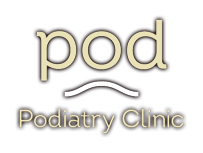Pod Podiatry Clinic provides specialist heel pain treatments.
Heel pain is a very common foot problem with the sufferer usually feeling pain under the heel (heel spur syndrome or plantar fasciitis), or at the back of the heel where the Achilles tendon connects to the heel bone (Achilles tendonitis).
There are 26 bones in the foot, of which the heel (calcaneus) is the largest. When we are walking and running the heel absorbs the impact of the foot as it hits the ground, and with the plantar fascia and Achilles, springs us forward into our next stride. It is estimated that the stress placed on a walking foot may be 1.25 times bodyweight, and 2.75 times when running. This makes the heel vulnerable to damage and pain.
The causes of heel pain are mostly mechanical and related to foot structure and position during gait. Commonly, sufferers experience pain after rest with symptoms worse getting out of bed or after rest during the day.
Plantar fasciitis is an inflammation of the plantar fascia, a tough bow-like ligament running from the heel to the forefoot. Experienced as pain either close to the heel or in the arch of the foot. Commonly associated with excessive pronation of the foot (arch rolling in excessively). In severe cases the plantar fascia may tear.
Heel bumps often associated with flat feet. Pressure on the heel from ill-fitting footwear results in the formation excessive bone. Heel bursitis (swelling of a fluid sac) may also be present.
Achilles tendonosis is a chronic condition associated with the progressive degeneration of the Achilles tendon. Multiple minor, microscopic tears of the tendon which cannot heal and repair correctly if the tendon is under more stress than it can cope with. Eventually the tendon thickens with fluid, weakens and becomes painful.
Tarsal tunnel syndrome – a large nerve in the rear foot becomes entrapped and compressed causing pain.
Sever’s disease (calcaneal apophysitis) is the most common cause of heel pain in growing children, caused by trauma to the growth plate in the heel bone. Usually found in the 9 to 14 year age group and in children participating in multiple sports.
All of these conditions require correct diagnosis with the aid of biomechanical assessment (the study of how the foot is constructed and how it functions when walking and running), and sometimes diagnostic ultrasound or x ray. There are many treatments available including muscle stretching and strengthening, taping, changing footwear, anti-inflammatory medications, percussive therapy, laser treatment and altering how the foot functions through the use of motion control foot orthoses.

Comments are closed.